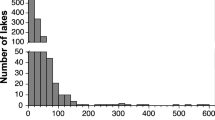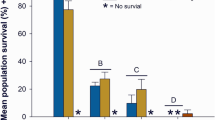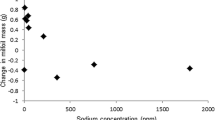Abstract
Freshwater salinization is an emerging global concern, and in northern latitudes can be largely attributed to road deicer applications during winter and spring. To investigate the effects of road salt contamination on pond food webs, we manipulated trophic structure and salt in experimental pond communities. In May 2008, we inoculated forty 600-L pond mesocosms with algae and zooplankton. Using a full-factorial design, we manipulated road salt presence (645 mg L−1 Cl−) and tadpoles (Hyla versicolor) in a food web that included two groups of primary producers (periphyton, phytoplankton) and two groups of primary consumers (tadpoles, zooplankton). Adult copepod density decreased significantly in the elevated chloride treatment (ANOVA P = 0.001). Tadpoles reared in the elevated chloride treatment grew larger (ANOVA P = 0.005) and metamorphosed sooner (ANCOVA P = 0.028) than those in the ambient treatment. Our results suggest there were more algal resources available to tadpoles as a result of declines in zooplankton, inducing a shorter time to and greater size at metamorphosis. While common pollutants such as road deicers are known to have direct effects on many taxa, the indirect effects on food web structure and interactions can be pronounced, even when pollutants occur at relatively low levels.


Similar content being viewed by others
References
Abrams PA (2004) Trait-initiated indirect effects due to changes in consumption rates in simple food webs. Ecology 85:1029–1038
Altig R, Whiles MR, Taylor CL (2007) What do tadpoles really eat? Assessing the trophic status of an understudied and imperilled group of consumers in freshwater habitats. Freshw Biol 52:386–395
Arnold WR, Diamond RL, Smith DS (2010) The effects of salinity, pH, and dissolved organic matter on acute copper toxicity to the rotifer, Brachionus plicatilis (“L” strain). Arch Environ Contam Toxicol 59:225–234
Berven KA, Gill DE (1983) Interpreting the geographic variation in life-history traits. Am Zool 23:85–97
Bishop CA, Struger JS, Shirose JL, Dunn L, Campbell DG (2000) Contamination and wildlife communities in stormwater detention ponds in Guelph and the Greater Toronto Area, Ontario, 1997 and 1998 Part II – Contamination and biological effects of contamination. Water Quality Resources Journal of Canada 35:437–474
Boone MD, Semlitsch RD, Fairchild JF, Rothermel BB (2004) Effects of an insecticide on amphibians in large-scale experimental ponds. Ecol Appl 14:685–691
Brand A, Snodgrass J, Gallagher M, Casey R, Van Meter R (2010) Lethal and sublethal effects of embryonic and larval exposure of Hyla versicolor to stormwater pond sediments. Arch Environ Contam Toxicol 58:325–331
Calef GW (1973) Natural mortality of tadpoles in a population of Rana aurora. Ecology 54:741–758
Chinathamby K, Reina RD, Bailey PCE, Lees BK (2006) Effects of salinity on the survival, growth and development of the brown tree frog (Litoria ewingii). Aust J Zool 54:97–105
Derry AM, Prepas EE, Hebert PDN (2003) A comparison of zooplankton communities in saline lakewater with variable anion composition. Hydrobiologia 505:199–215
Dickman M (1968) The effect of grazing by tadpoles on the structure of a periphyton community. Ecology 49:1188–1190
Dougherty CK, Smith GR (2006) Acute effects of road de-icers on the tadpoles of three anurans. Appl Herpetol 3:87–93
Dunson WA, Travis J (1991) The role of abiotic factors in community organization. Am Nat 138:1067–1091
Elphick JRF, Bergh KD, Bailey HD. Chronic toxicity of chloride to freshwater species: Effects of hardness and implications for water quality guidelines. Environmental Toxicology and Chemistry in press
Environment Canada (2001) Priority substances list assessment report on road salts under the Canadian Environmental Protection Act
Fleeger JW, Carman KR, Nisbet RM (2003) Indirect effects of contaminants in aquatic ecosystems. Sci Total Environ 317:207–233
Gallagher M (2009) Wood frog (Rana sylvatica) use and reproductive success in stormwater ponds of varying contaminant levels. MS Thesis, Towson University, Department of Biological Sciences, Towson, Maryland, USA
Gosner KL (1960) A simplified table for staging anuran embryos and larvae with notes on identification. Herpetologica 16:183–190
Harmon SM, Specht WL, Chandler GT (2003) A comparison of the Daphnids Ceriodaphnia dubia and Daphnia ambigua for their utilization in routine toxicity testing in the Southeastern United States. Arch Environ Contam Toxicol 45:79–85
Hart BT, Bailey P, Edwards R, Hortle K, James K, McMahon A, Meredith C, Swadling K (1991) A review of the salt sensitivity of the Australian freshwater biota. Hydrobiologia 210:105–144
Hauer FR, Lamberti GA (eds) (2006) Methods in stream ecology, 2nd edn. Academic, San Diego
Howard KWF, Maier H (2007) Road de-icing salt as a potential constraint on urban growth in the Greater Toronto Area, Canada. J Contam Hydrol 91:146–170
Jackson RB, Jobbagy EG (2005) From icy roads to salty streams. P Natl A Sci USA 102:14487–14488
Karraker NE (2007) Investigation of the amphibian decline phenomenon: novel small-scale factors and a large-scale overview. Ph.D. dissertation, State University of New York, College of Environmental Science and Forestry, Syracuse, New York, USA
Kaushal SS, Groffman PM, Likens GE, Belt KT, Stack WP, Kelly VR, Band LE, Fisher GT (2005) Increased salinization of fresh water in the northeastern United States. P Natl A Sci USA 102:13517–13520
Kelly VR, Lovett GM, Weathers KC, Findlay SEG, Strayer SL, Burns DJ, Likens GE (2008) Long-term sodium chloride retention in a rural watershed: legacy effects of road salt on streamwater concentration. Environ Sci Technol 42:410–415
Leips J, McManus MG, Travis J (2000) Response of treefrog larvae to drying ponds: comparing temporary and permanent pond breeders. Ecology 81:2997–3008
Lilius H, Hastbacka T, Isomaa B (1995) A comparison of the toxicity of 30 reference chemicals to Daphnia magna and Daphnia pulex. Environ Toxicol Chem 14:2085–2088
Littell RC, Milliken GA, Stroup WW, Wolfinger RD, Cary NC (1996) SAS Systems for mixed models. SAS Institute Inc., pp 633
McDiarmid RW, Altig R (eds) (1999) Tadpoles: the biology of Anuran Larvae. The University of Chicago Press, Chicago
Mezquita F, Griffiths HI, Dominques MI, Lozano-Quillis MA (2001) Ostracods (Crustacea) as ecological indicators: a case study for Iberian Mediterranean brooks. Archives Fur Hydrobiologie 150:545–560
Morgan RP II, Kline KM, Cushman SF (2007) Relationships among nutrients, chloride and biological indices in urban Maryland streams. Urban Ecosyst 10:153–166
Mullaney JR, Lorenz DL, Arntson AD (2009) Chloride in groundwater and surface water in areas underlain by the glacial aquifer system, northern United States. U.S. Geological Survey Scientific Investigations Report 2009–5086, pp 41
Olding DD (2000) Algal communities as a biological indicator of stormwater management pond performance and function. Water Qual Resour J Can 35:489–503
Palmer CG, Muller WJ, Gordon AK, Scherman PA, Davis-Coleman HD, Pakhomova L, de Kock E (2004) The development of a toxicity database using freshwater macroinvertebrates, and its application to the protection of South African water resources. S Afr J Sci 100:643–650
Petranka WJ, Doyle EJ (2010) Effects of road salts on the composition of seasonal pond communities: can the use of road salts enhance mosquito recruitment? Aquat Ecol 44:155–166
Pilkaityte R, Schoor A, Schubert H (2004) Response of phytoplankton communities to salinity changes—a mesocosm approach. Hydrobiologia 513:27–38
Radke LC, Juggins S, Halse SA, De Deckker P, Finston T (2003) Chemical diversity in south-eastern Austrian saline lakes II: biotic implications. Mar Freshw Res 54:895–912
Relyea RA, Hoverman JT (2008) Interactive effects of predators and pesticides on aquatic communities. Oikos 117:1647–1658
Relyea RA, Schoeppner NM, Hoverman JT (2005) Pesticides and amphibians: the importance of community context. Ecol Appl 15:1125–1134
Rohr JA, Kerby JL, Sih A (2006) Community ecology as a framework for predicting contaminant effects. Trends Ecol Evol 21:606–613
Sanzo D, Hecnar H (2006) Effects of road de-icing salt (NaCl) on larval wood frogs (Rana sylvatica). Environ Pollut 140:247–256
Sarma SSS, Nandini S, Morales-Ventura J, Delgado-Martinez I, Gonzalez-Valverde L (2006) Effects of NaCl salinity on population dynamics of freshwater zooplankton (rotifers and cladocerans). Aquat Ecol 40:349–360
SAS Institute Inc., SAS 9.1.3 Help and Documentation, Cary, NC: SAS Institute Inc., 2000–2004
Seale DB (1980) Influence of amphibian larvae on primary production, nutrient flux, and competition in a pond ecosystem. Ecology 61:1531–1550
Smith DC (1987) Adult recruitment in chorus frogs: effects of size and date at metamorphosis. Ecology 68:344–350
Snodgrass JW, Casey RE, Joseph D, Simon JA (2008) Microcosm investigation of stormwater pond sediment toxicity to embryonic and larval amphibians: variation in sensitivity among species. Environ Pollut 154:291–297
Strauss SY (1991) Indirect effects in community ecology: their definition, study and importance. Trends Ecol Evol 6:206–210
Transportation Research Board (2004) Snow and Ice Control: Guidelines for Materials and Methods. National Cooperative Highway Research Program, Report 235, pp 50
Travis J (1983) Variation in development patterns of larval anurans in temporary ponds. I. Persistent variations within a Hyla gratiosa population. Evolution 37:496–512
Turner Designs (2006) Trilogy Laboratory Fluorometer User’s Manual. Version 1.1. P/N 998–7210, pp 38. Sunnyvale, CA
Vonesh JR, Kraus JM (2009) Pesticide alters habitat selection and aquatic community composition. Oecologia 160:379–385
Wassersug RJ (1974) Evolution of anuran life cycles. Science 185:377–378
Wassersug RJ (1975) The adaptive significance of the tadpole stage with comments on the maintenance of complex life cycles in anurans. Am Zool 15:405–417
Wootton JT (1994) The nature and consequences of indirect effects in ecological communities. Annu Rev Ecol Syst 25:443–466
Acknowledgments
We thank the Patuxent Wildlife Research Center staff for authorizing access to wetland impoundments and for research guidance. Many hours of field and laboratory assistance were given by Matt Gallagher, Adrianne Brand, Carrie DePalma, Jen Li, Pete Bogush, Josh Jones, Catie Iacovino, Joshua Plaschkes, Saliha Khan, Chance Pascale, Melanie Harrison, Dan Miles, Yvette Williams and Crystal Spinks. We gratefully acknowledge support from the US National Science Foundation (NSF), Long-Term Ecological Research (DEB-0423476) and Integrated Graduate Education Research and Training programs (NSF award #0549469), and the US Geological Survey (Project # 2008MD171B). The opinions and findings expressed in this paper are those of the authors and not of the National Science Foundation.
Author information
Authors and Affiliations
Corresponding author
Rights and permissions
About this article
Cite this article
Van Meter, R.J., Swan, C.M., Leips, J. et al. Road Salt Stress Induces Novel Food Web Structure and Interactions. Wetlands 31, 843–851 (2011). https://doi.org/10.1007/s13157-011-0199-y
Received:
Accepted:
Published:
Issue Date:
DOI: https://doi.org/10.1007/s13157-011-0199-y




